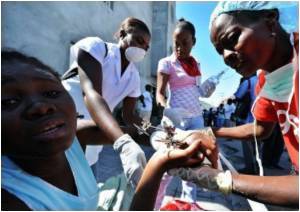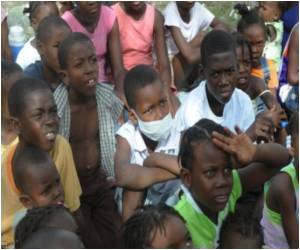
The project is in full swing at the site of the REU School in the Canape Vert neighborhood, where temporary sheds have replaced the main building that was razed by the January 12 earthquake that killed more than 250,000 Haitians, including a dozen of the school's students and one teacher.
"We have resumed school, but the atmosphere is not good. Conditions are difficult for pupils and teachers who are still living in tents," said principal Magalie George.
But thanks to a thriving school lunch program boosted in the wake of the disaster, half the students have now returned to class at the public school -- a French abbreviation of Republique des Etats-Unis, and named after Haiti's wealthy American neighbor to the north.
"Children are more motivated when they are assured of a meal," George stressed.
About 1,400 children from the slums attend the school, and providing them with one square meal a day is a relief for mothers who can not always provide for their children, said the principal as she oversaw delivery of a truckload of aid from the UN's World Food Programme (WFP).
Advertisement
Little Nedjima said she is grateful, especially since the 11-year-old and her four brothers and sisters are not always well fed at home.
Advertisement
Nationwide, the UN is feeding up to 800,000 Haitian schoolchildren.
"Together with the school meals program of the government, we are targeting more than one million children this year," said Anne Poulsen, a WFP spokeswoman.
The agency's representative in Haiti, Myrta Kaulard, is quick to point to the devastating impact that the magnitude 7.0 quake has had on the school system, and the need to rebuild schools and provide the right environment for schoolchildren, or risk losing a generation of Haitian youth.
"The meal program has become even more important after the earthquake," Kaulard said.
Through the innovation, the Haitian government seeks to allow more than two million schoolchildren to receive one meal per day, all while encouraging domestic agricultural production.
"We buy products from small Haitian growers," said the WFP representative, whose agency also feeds another 600,000 Haitian infants and pregnant women.
On this particular day after lunch, served in a makeshift cafeteria provided through a US donation, students also received a food ration of a few kilos (pounds) of rice and soy beans and one liter of cooking oil for the home.
"They went away relieved, knowing that their brothers and sisters can also eat," said psychologist Ronald Jean-Louis.
"The trauma of 12 January is still alive in the minds of the young, their parents and teachers, because we still live with the rubble piled in the street near the school," he added.
For many children, like 10-year-old Evelyne, studying near the crumbled remains of their former school have become sadly commonplace.
"Working in an open space is better, because we know that we won't be wiped out if there is another earthquake," she said.
Source-AFP










